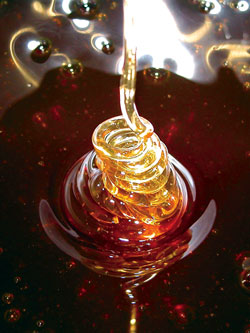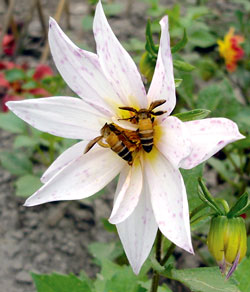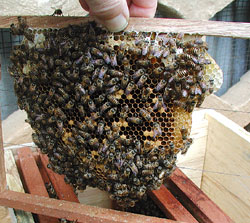 Honey isn't just sweet. The thin, pale gold, mass-market brands are vitamin-rich, antibacterial, anti-fungal, and other good stuff. But there's also a whole world of exquisite tastes, and some varieties of Nepali honey can be the stuff of connoisseurs.
Honey isn't just sweet. The thin, pale gold, mass-market brands are vitamin-rich, antibacterial, anti-fungal, and other good stuff. But there's also a whole world of exquisite tastes, and some varieties of Nepali honey can be the stuff of connoisseurs.
The dark, musky, slightly bitter buckwheat-based honey and paler, more complexly perfumed mustard-based honey are excellent additions to any breakfast or baking. Varieties like these, as well as lychee, chiuri, and rapeseed are unique to this part of the world, and they're seldom seen in European or North American stores.
Nepal's honey production is four times the 250 metric tonnes annual domestic demand, says the Department of Food Technology and Quality Control.
Honey producers here know that they can potentially create lucrative niche markets overseas, such as organic honey, 'Himalayan honey' and 'honey from the highlands', says Mahalaxmi Shrestha, secretary of Apiculturist Network.
"Nepal is rich in biodiversity, our bees feed on the nectar of flowers and fruits that are not available in many parts of the world," agrees Surendra Raj Joshi of GTZ's Private Sector Promotion/Rural Finance Nepal. "The taste, quality, and standard of Nepali honey are among the best in the world."
But producers are finding it remarkably difficult to meet international standards. The problem is documentation. Recently Nepali honey was banned from the European market because the Department of Food Technology and Quality Control failed to submit the Pesticide Residue Control Plan that EU regulations require.
Producers also slipped up, failing to have their honey tested by international standards laboratories before export.
Entrepreneurs and department officials say that amid the instability of recent years, honey export was laughed off the priority list. "But even if we couldn't get together a Pesticide Residue Control Plan, we should still have provided some documentation proving our honey is safe. Our main market, Norway, was wiped out," says Ganesh Dawadi of Department of Food Technology and Quality Control.
|
|
The exponential increase in production combined with a low initial investment, meant that beekeeping has became a vibrant commercial activity in the hills and tarai. "A recent survey of 350 beekeepers across Nepal shows that a household can increase its net annual income by over Rs 11,000 through beekeeping and honey production," says Bhimendra Katwal of Winrock Nepal's Farmer-to-Farmer Program. Dabur Nepal alone collects and produces 108 metric tonnes of honey every year. The Bee Development Section in Godavari estimates that, in the last three years alone, honey production in Nepal has nearly doubled. About 50,000 households now contribute to the 1,000 tonnes of honey being produced in Nepal each year.
The health benefits of honey are getting wider play too, from the word-of-mouth marketing of small producers, to Dabur's massive marketing campaign with Amitabh Bachchan chatting up a bottle of Dabur's best. "We just distribute through supermarkets and we're doing fine," says Prem Singh of Stone Bee Concern, whose labels list benefits ranging from aiding bronchitis to burns.
The Beekeeping Shop in Lagankhel , which sells three to four tonnes of honey every year through their shop and trade fairs, also caters to apiary enthusiasts-you can buy bees, hives, protective gear, the works.
Beekeepers need to upgrade their skills, says Ed Levi, a Winrock volunteer, to raise healthy bees and breed quality queens. Production needs to be streamlined and systematised to bring down costs, and quality control must be a higher priority, entrepreneurs say.
Queen bee
|
|
"We decided to promote the new bees in the tarai, since we weren't sure they'd survive at higher altitudes," said Jaya Kumar KC, chief of the Bee Development Section. Also, the exotics need to migrate, which is easier in the tarai, and require lots of forage space and large pasturelands to feed on. Although A. milefera is more productive, it is also vulnerable to diseases.
Cross-breeding is a concern, because each variety of bee thrives in different conditions, says Sanjaya Bista, a scientist at the Entomology Division of the National Agriculture Research Council. The native A. cerana needs help during chiuri flowering season, though, so the imports are transported up for the feeding season. "But farmers understand that the two breeds cannot be mixed together, therefore when the feeding is over, they take the melifera back," adds KC.




